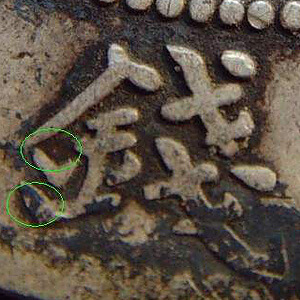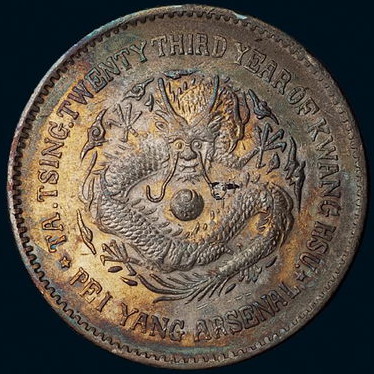The 1903 Chihli dollar (Y73.1) is much scarcer than its sister Chinese silver dollar, the famous Y73.2 made in 1908 (see related articles), but it is also somewhat less studied. Currently, only the variety with a full-stop after PEIYANG is acknowledged by grading agencies. There exists actually much more interesting and rare varieties, which are actively sought after in China. Similarly to the 1908 Chihli dollar, this 1903 dragon coin has been minted in several version with different typography for the date. The most dramatic is the 艺术字 (artistic font):
Besides the roman numerals, another device to examine carefully is the 錢 character on the reverse of the coin. On the full-stop after PEI YANG coins, the 金 part (radical) on the left of the 錢 character has been calligraphied in four different ways:
The picture 1 is representative of what you see on 90% of Y73.1 dragon dollars: this is the most common variety. The calligraphy shown on picture 3 is called 中折金 and is much scarcer: both side strokes of the 金 radical are curved in a very noticeable way. Even more rare, the 挑金 variety (picture 2) is easily identified by its incurved left stroke. The rarest of all the varieties is the 双折金, with characteristic vigorous tapered strokes on the side and bottom (see picture 4 and details).
If like me you collect Pei Yang 29th year Chinese silver dollars, be on the lookout for these rare varieties: while they enjoy some popularity in China, most collectors abroad are still unaware of them, so there is good opportunities around.
A reader from Germany contacted me recently about an enigmatic coin he bought on the flea market for 5 Euros. While not a coin collector, he loves curiosities and was profundly intrigued by this unusual Dragon Dollar…
… a beautiful Almond Eyed Dragon from the Peiyang Arsenal mint, one of the rarest variety of an already scarce type. It was obviously handled with great care; the dragon had kept all its scales, his fierce eyes still as piercing as a hundred years ago, when it first went out of the Peiyang Arsenal.
Without the mounting marks at 4 and 8 o’clock, this coin would be worth at least 4,000 Euros!
The design of the early Peiyang dragons is interesting as it is very strictly conforming to the traditional nine anatomical attributes of the Chinese Dragon:
- Deer horns
- Camel head
- Demon eyes
- Bull ears
- Snake neck
- Sea-serpent (蜃) belly
- Carp scales
- Eagle claws
- Tiger soles
Additionally, the Chinese dragon has a growth on his forehead, the Chĭ Mù (尺木), without which it is unable to ascend to the sky (龙无尺木,无以升天).
The depiction of the dragon on the coins issued in the 23rd year of Guāng Xù has been altered multiple times, with most changes related to the dragon’s eyes – probably due to the difficulty in finding a Demon to pose and capture its gaze…
The Evil-eyed Dragon (三角眼)
The dragon engraved on this first variety has evil, sightless “Triangle Eyes“, not unlike the 1896 test piece. It had most likely a high mintage, since it is only slightly scarcer than the most common variety for this year, the Beady Eyed Dragon, but it is hard to find in good condition nonetheless. Most of the surviving coins are worn out and damaged. There exists two additional variations of the “Evil Eyed Dragon”, both extremely rare:
The Almond-eyed Dragon (过渡眼三角眼)
This beautiful die variation can seem superficially very similar to the Evil Eyed Dragon, with only the addition of irides to the previously blind triangle eyes. However, by looking carefully, one can see clearly that this variety is not a mere modification of the original “Evil Eyed Dragon” but a whole revision of the initial pattern. The shape of the clouds surrounding the dragon is different, more intricate. The thigh of the dragon is now shorter. Five dots disposed in a cross pattern were also added to the pearl of wisdom. This type is only second in rarity to the mysterious Hidden Cross and Hidden Rose varieties.
The Beady-eyed Dragon (圆眼龙)
The Beady Eyed Dragon (which is the most common variant of the 1897 Peiyang dollar) has rounded eyes, contrary to the all the previous dies made that year. Like the Almond Eyed Dragon, it is a complete redesign, with the surrounding clouds and the shape of the eyes being modified. The change from a triangular to a rounded shape will persist in all the subsequent issues of the Peiyang mint.
The Dog-headed Dragon (狗头龙)
This very rare type is the last one minted in the 23rd year of Kwang Hsü. The dragon’s head has been completely redesigned, with short horns and a much bigger Chĭ Mù (尺木) on his forehead. The shape and style of the clouds has also been refined. This coin likely served as the prototype for the 24th year of Guāng Xù dollar, which keeps most of the new cloud details and the same Dragon face, although engraved in a crude fashion. The very striking difference in style makes me wonder if the Dog Headed Dragon dies could have been commissioned from another mint, but there is no conclusive evidence to support this theory.
All these dragon dollars are hard to find nowadays, due to the initial unpopularity of these coins: they were the first Chinese coinage denominated in Yuan (圆) and Jiao (角), while the whole country was still using the traditional monetary system based on weight. Their rejection caused most of them to be melted in order to mint new coins denominated in Mace and Candareens.
Congratulations to our German reader for making such a wonderful Snäppchen!











